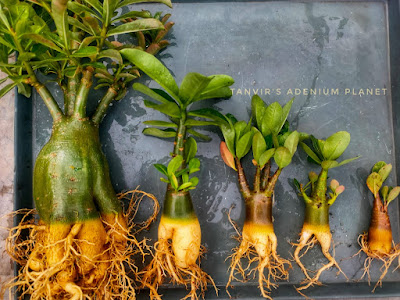Care of Adeniums (Desert Rose) Plants: The Ultimate Guide
Care of Adeniums (Desert Rose) Plants: The Ultimate Guide
If you're an avid gardener or plant enthusiast, you've probably come across the stunning Adenium plant, also known as the Desert Rose. Known for its unique appearance and beautiful flowers, Adeniums have become a popular choice for gardeners worldwide. However, caring for these plants can be challenging, and many people struggle to keep them healthy and thriving. In this ultimate guide, we'll cover everything you need to know to keep your Adenium plant in excellent condition.
Section 1: Introduction
Adenium plants are native to arid regions of Africa, Arabia, and Madagascar. They are succulent plants that have a swollen, bulbous trunk that tapers into branches with beautiful pink or red flowers that resemble roses. These plants are prized for their beautiful blooms, but they also make a unique addition to any garden with their unique appearance.
Section 2: Light Requirements
Adenium plants require plenty of sunlight to thrive. They should be placed in a sunny area that receives at least six hours of direct sunlight every day. If your plant is not receiving enough sunlight, it may not flower or grow correctly. However, be careful not to expose your Adenium to too much direct sunlight, as this can damage the leaves.
Section 3: Watering
Adenium plants are succulent plants and store water in their swollen trunks. As such, they don't require frequent watering and should only be watered when the soil is dry. Overwatering can cause root rot and other issues, so it's essential to be careful not to overwater your plant. During the winter months, reduce watering to once a month.
Section 4: Soil Requirements
Adenium plants prefer well-draining soil that's rich in nutrients. It's best to use a sandy, loamy soil mix that allows for excellent drainage. Avoid using heavy clay soils or soils that hold too much moisture, as this can cause root rot and other problems.
Section 5: Fertilizing
Adenium plants require regular fertilizing to stay healthy and produce beautiful blooms. You can use a balanced fertilizer that's high in phosphorous to encourage blooming. However, be careful not to over-fertilize your plant, as this can damage the roots.
Section 6: Pruning
Adenium plants require regular pruning to maintain their shape and encourage new growth. You should prune your plant in the early spring before it starts to grow. Cut back any dead or damaged branches, and trim any branches that are too long or out of shape. Regular pruning will help your plant stay healthy and produce more blooms.
Section 7: Pests and Diseases
Adenium plants are susceptible to a variety of pests and diseases. Some of the most common pests that affect Adeniums include spider mites, scale insects, and mealybugs. To prevent pests from infesting your plant, be sure to keep it clean and free of debris. If your plant does become infested, you can use a mild insecticide to get rid of the pests.
Section 8: Propagation
Adenium plants can be propagated through seeds, cuttings, or grafting. If you want to propagate your plant through cuttings, wait until the early spring when the plant is starting to grow. Cut a branch from the plant and allow it to dry for several days. Then, plant the cutting in a pot filled with well-draining soil and keep it moist until it takes root.
FAQs
Q1. Can Adenium plants survive in cold temperatures?
A1. Adenium plants are tropical plants and cannot tolerate freezing temperatures. If the temperature drops below 40 degrees Fahrenheit, your Adenium plant may suffer damage or even die.
Q2. Can Adenium plants grow in containers?
A2. Yes, Adenium plants can grow in containers, and they make a beautiful addition to any patio or balcony. Just be sure to use a well-draining potting mix and a container with drainage holes.
Q3. How often should I fertilize my Adenium plant?
A3. Adenium plants should be fertilized every two to three weeks during the growing season. Use a balanced fertilizer that's high in phosphorus to encourage blooming.
Q4. Can Adenium plants tolerate drought?
A4. Adenium plants are succulent plants and can tolerate drought conditions. However, it's important to avoid overwatering or underwatering your plant, as this can cause stress and damage.
Q5. How do I know if my Adenium plant is getting too much or too little sunlight?
A5. If your Adenium plant is getting too much sunlight, the leaves may turn yellow or brown and become crispy. If it's not getting enough sunlight, the leaves may become soft and pale. Be sure to monitor your plant's leaves and adjust its location accordingly.
Conclusion
In conclusion, caring for an Adenium plant may seem daunting at first, but with the right care and attention, your plant can thrive and produce beautiful blooms. Remember to provide your plant with plenty of sunlight, well-draining soil, and avoid overwatering. Regular pruning, fertilizing, and pest control can help your Adenium plant stay healthy and beautiful. By following the tips and information provided in this guide, you'll be on your way to growing a healthy and thriving Adenium plant in no time.


